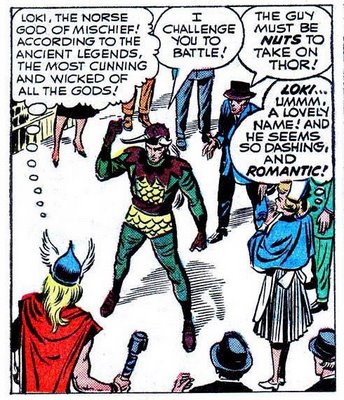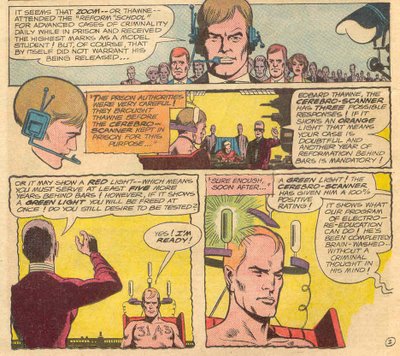As remarked by Thelonius Nick in the comments on the earlier Thor post, Stan Lee seemed unsure as to what to do with the Mighty Thor at first. The Thunder God was far too powerful and cosmic a character to waste against the usual crooks & mobsters. In Journey into Mystery #87 he defeats a plot by the communists to kidnap American scientists.
Loki returns in #88. Having learned of Thor's secret identity, he forces the Thunder God to choose between recovering the hammer and saving Jane Foster. Then Loki surrounds the hammer with a force field, preventing the now helpless Don Blake from recovering his powers. Fortunately Don tricks Loki into removing the force field and sends Loki back to Asgard.
In #89 Don and Jane are kidnapped by mobsters to operate on a wounded crime boss. In a classic example of Deus Ex Machina, he prays to Odin to intervene when he and Jane are about to be killed despite saving the mobster's life. Odin sends down a thunderbolt to save them. We also get a new power for Thor (that is never again mentioned); that of super-ventriloquism.
In #90, Thor again fights aliens. Ho-hum.
Lee still had not found the right format for the Mighty Thor in these issues. Nobody really seems able to handle the Thunder God, and so the plot often revolves around him somehow losing control of his hammer, despite its well-established tendency to return to him.
This is similar to the problems that DC had with Superman in the 1940s. DC had solved it by using deceptive villains like Mxyzptlk, the Prankster and Wolfingham; even Luthor was usually operating behind the scenes. But of course, this had the tendency to diminish the value of the powers that Superman possessed, which, after all, was what made the character different.
More about →
Loki returns in #88. Having learned of Thor's secret identity, he forces the Thunder God to choose between recovering the hammer and saving Jane Foster. Then Loki surrounds the hammer with a force field, preventing the now helpless Don Blake from recovering his powers. Fortunately Don tricks Loki into removing the force field and sends Loki back to Asgard.
In #89 Don and Jane are kidnapped by mobsters to operate on a wounded crime boss. In a classic example of Deus Ex Machina, he prays to Odin to intervene when he and Jane are about to be killed despite saving the mobster's life. Odin sends down a thunderbolt to save them. We also get a new power for Thor (that is never again mentioned); that of super-ventriloquism.
In #90, Thor again fights aliens. Ho-hum.
Lee still had not found the right format for the Mighty Thor in these issues. Nobody really seems able to handle the Thunder God, and so the plot often revolves around him somehow losing control of his hammer, despite its well-established tendency to return to him.
This is similar to the problems that DC had with Superman in the 1940s. DC had solved it by using deceptive villains like Mxyzptlk, the Prankster and Wolfingham; even Luthor was usually operating behind the scenes. But of course, this had the tendency to diminish the value of the powers that Superman possessed, which, after all, was what made the character different.
































